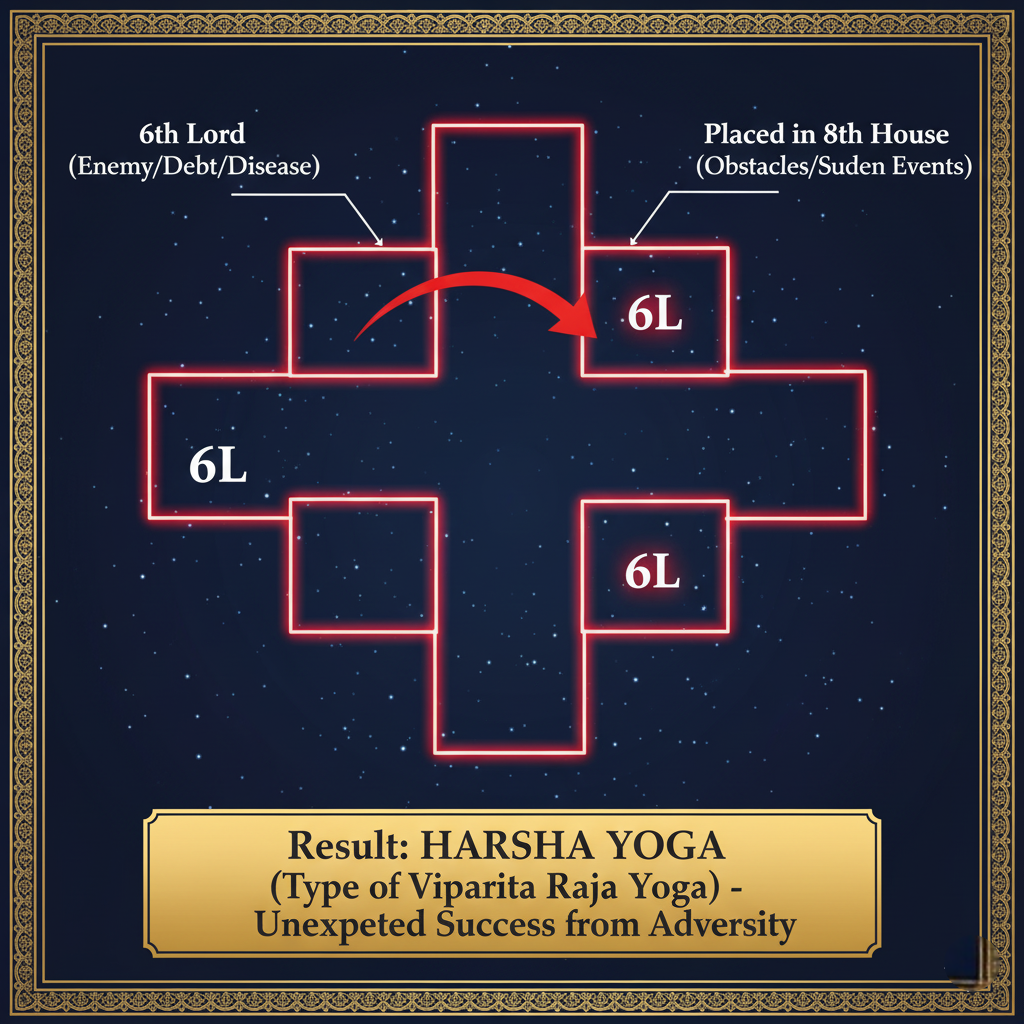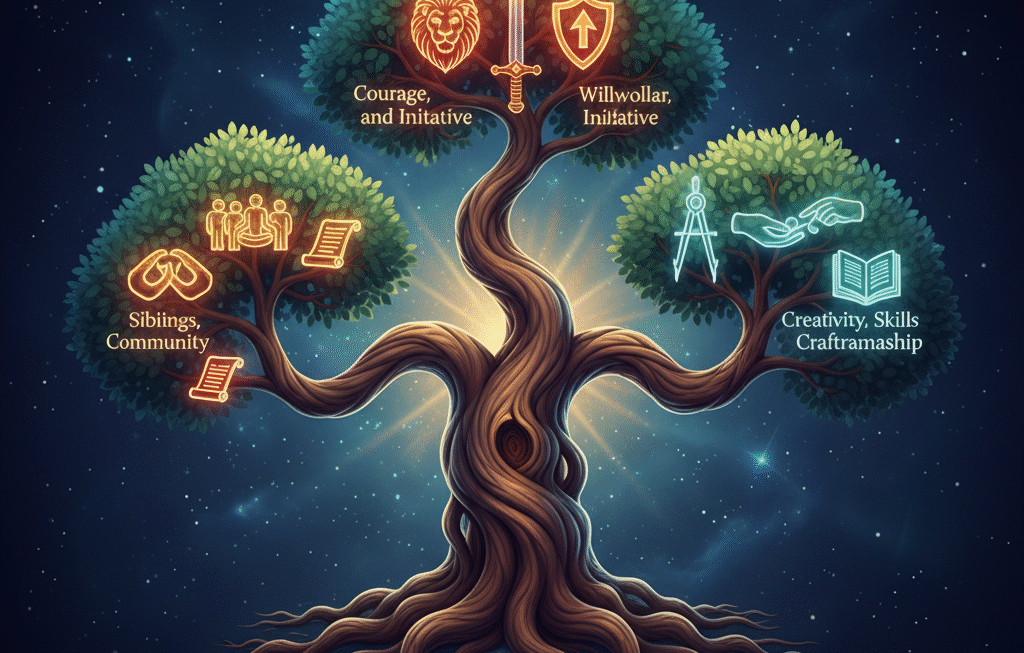Is it possible for the most challenging planetary placements in Vedic astrology to unexpectedly produce results of power, wealth, and status? While Jyotish often emphasizes the strength of benefic houses, there exists a fascinating and counter-intuitive category of yogas where adversity itself becomes the catalyst for extraordinary success. This paradoxical pathway to prominence is known as Viparita Raja Yoga. Understanding this unique yoga is key to recognizing hidden potentials for resilience and surprising triumph within a horoscope, proving that even difficult placements can hold the seeds of greatness.
Astrological Yogas: Unlocking the Chart’s Complex Code
Before we explore this specific ‘reverse’ combination, let’s briefly revisit the concept of Yogas. In Vedic astrology, a Yoga is a special planetary configuration formed by the placement, association, or aspect between planets.
These planetary yogas are not merely abstract formulas; they are astrological circuits that channel planetary energies in specific ways, indicating potential life outcomes. They form the underlying structure for interpreting combinations in astrology, revealing possibilities that range from spiritual insight to worldly challenges.

What is Viparita Raja Yoga? Gain Through Adversity
(Opinion): Viparita Raja Yoga (literally “Inverted/Adverse Royal Union”) is a unique and often powerful type of Raja Yoga in Vedic astrology. Unlike conventional Raja Yogas formed by benefic house lords, this yoga arises from specific placements of the lords of the ‘Dusthana’ houses (6th, 8th, and 12th) – houses traditionally associated with difficulties, obstacles, and losses.
When formed correctly, it indicates that the individual achieves significant success, wealth, or status unexpectedly, often arising from or coinciding with periods of struggle, loss, or the downfall of others. It’s the astrological signature of turning lemons into lemonade on a grand scale.
(Reason): Why does such a seemingly negative setup produce positive results? The logic behind Viparita Raja Yoga is intriguingly strategic. The Dusthana houses (6th – enemies, debt, disease; 8th – obstacles, death-like experiences, hidden matters; 12th – losses, expenses, isolation) and their lords are inherently challenging. However, when the lord of one Dusthana house is placed in another Dusthana house, the principle is that these malefic lords, by being situated in difficult environments, primarily inflict their negative effects upon each other or upon the challenging significations of the house they occupy, rather than upon the native’s core well-being (represented by the Lagna and benefic houses).
It’s like placing two troublemakers in the same room where they end up neutralizing each other’s disruptive capacity, inadvertently creating a benefit for the owner of the house. This mutual affliction among challenging house lords cancels out much of their negative potential, allowing their underlying energy (which every planet possesses) to manifest in a surprisingly positive, ‘Raja Yoga’-like fashion, often triggered by an adverse event.
(Example): Consider the lord of the 6th house (enemies) placed in the 8th house (obstacles/sudden events). This might indicate that the individual gains unexpectedly due to the sudden downfall or misfortune of their competitors or adversaries.
If the 8th lord (obstacles/inheritance) is in the 12th house (loss/foreign lands), it might suggest gaining an inheritance after a period of difficulty, or finding unexpected success and wealth in a foreign land after initially feeling isolated or lost. If the 12th lord (loss/expenses) is in the 6th house (debt/service), it could mean overcoming debt successfully or achieving a high position in a service-oriented field after initial setbacks.
(Opinion/Restatement): Thus, Viparita Raja Yoga is a true reverse raja yoga. It doesn’t promise an easy path, but signifies the potential for significant gain, status, and success emerging from or facilitated by circumstances of loss, struggle, or adversity. It is the astrological signature of resilience leading to reward.
Dusthana Lords Yoga: The Formation Rules
(Pattern Spotting): How do you identify these dusthana lords yoga combinations in a birth chart? The formation requires a specific placement involving the lords of the 6th, 8th, and 12th houses.
The Core Rule: A Viparita Raja Yoga is formed when the lord of a Dusthana house (6th, 8th, or 12th) is placed in another Dusthana house (6th, 8th, or 12th), AND is relatively free from conjunction or aspect by benefic planets.
Let’s break this down:
- Identify the Dusthana Lords: Determine which planets rule the 6th, 8th, and 12th houses from the Ascendant (Lagna).
- Check Their Placement: See if any of these lords are positioned in one of the other Dusthana houses. For example, is the 6th lord in the 8th or 12th? Is the 8th lord in the 6th or 12th? Is the 12th lord in the 6th or 8th? (Note: A Dusthana lord placed in its own Dusthana house forms a different type of yoga, not typically Viparita Raja Yoga).
- Check for Benefic Influence: Crucially, for the true “Viparita” (adverse causing good) effect, the Dusthana lord involved should ideally be alone in the other Dusthana house, or only conjunct/aspected by other malefic planets (including other Dusthana lords). If strong benefic planets (Jupiter, Venus, well-associated Mercury, waxing Moon) are conjunct or strongly aspecting the Dusthana lord in its Dusthana placement, they tend to ‘rescue’ it or mitigate the initial adversity, potentially diluting the dramatic ‘reversal’ effect of the Viparita Raja Yoga.
The Three Types of Viparita Raja Yoga:
Based on which Dusthana lord is involved, there are three specific named yogas:
- Harsha Yoga (Joyful): Formed when the 6th lord is placed in the 8th or 12th house.
- Sarala Yoga (Straightforward/Easy): Formed when the 8th lord is placed in the 6th or 12th house.
- Vimala Yoga (Pure/Stainless): Formed when the 12th lord is placed in the 6th or 8th house.
Reverse Raja Yoga: Interpreting the Results
(Value): What are the life effects indicated by these unique dusthana combinations when they form a Viparita Raja Yoga? While each type has nuances, the general theme is success born from challenging circumstances.
- Harsha Yoga (6th lord in 8th/12th): Classically said to bestow happiness, good fortune, victory over enemies, good health (overcoming disease signified by 6th), freedom from debt, and association with powerful or illustrious people. The gain often comes through unexpected events (8th) or situations involving loss/foreign lands (12th) affecting adversaries (6th).
- Sarala Yoga (8th lord in 6th/12th): Said to grant intelligence, learning, longevity, fearlessness, prosperity, and the ability to overcome obstacles easily. Success might arise after navigating crises (8th) through service/conflict (6th) or by dealing with matters related to losses/foreign lands (12th). They seem to navigate difficult situations with surprising ease.
- Vimala Yoga (12th lord in 6th/8th): Said to bestow a virtuous character, independence, happiness, savings (despite 12th lord indicating expenses), and a good reputation. Success may come through managing losses effectively, working in service (6th), dealing with hidden matters (8th), or finding fortune in seclusion or foreign lands after initial expenditure or separation (12th). They often spend virtuously.
Common threads across all three reverse raja yoga types include:
- Unexpected Rise: Achieving success or status in a way that seems contrary to initial expectations or circumstances.
- Resilience: The ability to withstand and even thrive amidst difficulties.
- Benefit from Adversity: Gaining wealth, power, or recognition as a direct or indirect result of challenging situations, conflicts, or losses (either their own or others’).
Mythbusting: Why Don’t All Dusthana Lords in Dusthanas Bring Fortune?
(Engagement): Here’s the essential nuance. Simply seeing the 6th lord in the 8th house doesn’t automatically guarantee fame and fortune! The concept of Viparita Raja Yoga is potent but requires specific conditions to truly activate its “Raja Yoga” potential. Many charts have these placements, but the results vary drastically. Here’s why:
- Strength of the Dusthana Lord: This is paramount. For the yoga to function powerfully, the Dusthana lord involved must possess inherent strength (e.g., be in its own sign, exaltation sign – even within the Dusthana, have good Shadbala, be strong in divisional charts like Navamsa). A weak, afflicted Dusthana lord placed in another Dusthana will likely just suffer the negative consequences of both houses without the power to cause a positive reversal. It needs strength to “fight” the negativity.
- Freedom from Benefic Influence: As mentioned, the theory works best when the Dusthana lord is primarily interacting with other malefic energies. If strong benefics aspect or conjunct the Dusthana lord in its adverse placement, they tend to protect the person from the initial hardship, thereby reducing the dramatic “rebound” effect that characterizes the Viparita Raja Yoga. The adversity itself is the trigger.
- Strength of the Lagna and Lagna Lord: The Ascendant and its lord represent the individual’s core vitality and ability to withstand challenges. A strong Lagna/Lagna lord is essential to navigate the initial difficulties associated with the Dusthana placements before the positive reversal can occur. A weak Lagna might succumb to the adversity.
- Overall Chart Context: The presence of other powerful Yogas (like classical Raja Yogas or Dhana Yogas) can support and amplify the Viparita effects. Conversely, severe afflictions or strong Duryogas elsewhere in the chart can hinder its manifestation.
- Dasha Timing: The most dramatic results of a Viparita Raja Yoga are typically experienced during the Mahadasha (major period) and Antardasha (sub-period) of the specific Dusthana lord involved in the yoga. If this period arrives at a suitable age and the planet is strong enough, the unexpected rise can occur.
Therefore, identifying the basic Viparita structure is just the starting point. The strength of the involved lord, the lack of undue benefic interference, the overall resilience of the chart, and the timing of planetary periods are all critical factors in determining whether the yoga will deliver powerful, positive results or remain a latent potential amidst struggles.
Conclusion: The Silver Lining in Astrological Storms
Viparita Raja Yoga stands as a compelling example of the sophisticated and often paradoxical nature of Vedic astrology. It teaches us that challenging placements are not always purely negative and that strength and success can emerge from the most unexpected corners of the horoscope. This dusthana lords yoga signifies the potential for resilience, transformation, and gain through adversity.
Discovering a Viparita Raja Yoga in a chart offers a unique perspective, suggesting a life path where overcoming obstacles becomes the very mechanism for achieving status and success.
However, like all significant combinations in astrology, its true power and manifestation depend on a careful analysis of the involved planet’s strength, its interactions within the chart, and the unfolding timeline of the Dasha periods. It is a reminder that even in the face of astrological challenges, the potential for a surprising and powerful reversal often lies hidden, waiting for the right conditions to emerge.












